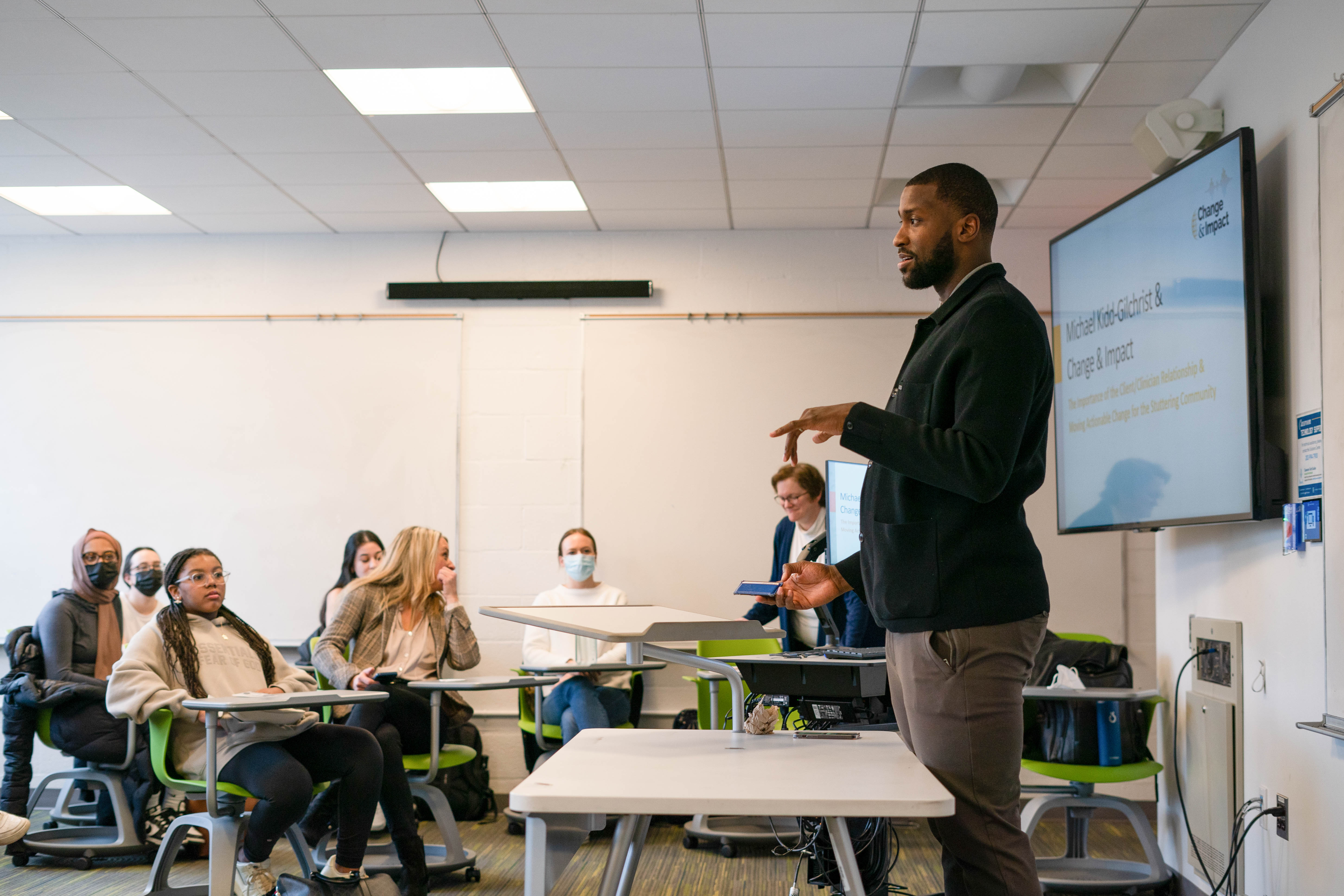For much of his life, Michael Kidd-Gilchrist wanted to be known as a basketball star—whether as a high school phenomenon in New Jersey, a champion at the University of Kentucky or a nine-year veteran in the NBA.
Today, as he recently told students in Speech, Language and Hearing Sciences Professor Shelley Brundage’s graduate seminar on Fluency Disorders, Kidd-Gilchrist is embracing an off-the-court identity.
“I’m a person who stutters,” he said. “I’m always going to stutter. That’s just who I am.”
The founder of an advocacy nonprofit called Change & Impact, Kidd-Gilchrist lobbies Capitol Hill for expanded healthcare coverage and regularly speaks at colleges and universities. But, as he shared with Brundage’s students, he was once so anxious about stuttering that he’d hide in his elementary school restroom when his class read aloud. Always surehanded with a basketball, he shied away from microphones and public speaking during his college and NBA careers.
“I want people to see that, even if we stutter, we aren’t dumb or stupid. It just takes us time to get our thoughts and our words out,” Kidd-Gilchrist said. “We want to be accepted for who we are.”
People who stutter have long endured stigma and stereotypes while undergoing treatment regimens from fluency drills and breathing strategies to electronic aids. For the 3 million people who experience stuttering, the brief interruptions in speech can lead to hardships like bullying and anxiety, struggles with personal relationships and discrimination in the job market.
But a growing wave of clinicians and activists like Kidd-Gilchrist are shifting focus away from stuttering as a hindrance and more toward “stuttering identity and acceptance,” said Brundage, chair of the Speech, Language and Hearing Sciences Department at the Columbian College of Arts & Sciences.
Co-author of the seminal text A Handbook on Stuttering, Brundage said the speech pathology field is reimagining the therapeutic relationship to meet the most pressing concerns of clients who stutter—whether it’s adults who want to establish a confident voice or children coping with teasing at school.
“Stuttering is more than just speech,” she said. “The person who stutters is the expert on their stuttering. We need to listen to what they want from us.”
Learning to Listen
Brundage characterizes stuttering as “a neurodevelopment disorder that begins in childhood and may remain into adulthood.” Each person’s stutter manifests in a different way, such as repeating words or halting on sounds and syllables. While its roots are complex, Brundage notes that research suggests the brains of children who stutter process speech and language differently. “Stuttering involves interactions between behaviors, thoughts, feelings and attitudes about communication— coupled with speech being a highly precise, highly fast process,” Brundage said. “It’s no wonder we still have so many questions.”
As many as 75 percent of children will stop stuttering with little intervention. In fact, Brundage said speech therapists often have scant experience treating stuttering—particularly in schools where, she estimates, an average annual caseload may include no more than one young person who stutters.
To help fill that knowledge gap, senior speech, language and hearing sciences major Julia Kerrigan researched how young people who stutter relate to their therapists as part of her Luther Rice Fellowship, a CCAS program that supports faculty-mentored student research.
After volunteering at nonprofit camps, Kerrigan, president of the GW chapter of the National Student Speech Language Hearing Association, analyzed data from interviews with children aged 8 to 17. Many expressed frustration with treatment techniques—“A lot of speech therapists are obsessed with tools,” one person said—and were eager to design their own therapeutic goals. One advised therapists to “try and find out what that person needs by listening to them.”
“Try to be supportive!” a young person said.
“These young people have layers of insight gained from moving through a world that wants to change them,” Kerrigan said. As therapists, “we need to do a better job of listening and connecting with them on the basis of their personhood.”
Speaking to Brundage’s class, Kidd-Gilchrist said he hopes to give the next generation of speech pathologists insights into the lived experiences of their future clients.
“There’s nothing like hearing personal anecdotes from somebody who is a member of the community that we will serve,” said Emily Donahue, a first year-graduate student. “We can read the textbooks and the research. But hearing him say, ‘This is how I look at my life,’ that hits home.”
With the support of family, teammates and therapists, Kidd-Gilchrist said he has become more accepting of his stutter as part of his identity. Watching with Brundage’s class, his 10-year-old daughter Mya said she’s never even discussed stuttering with her father. “We don’t question it. It doesn’t matter,” she said. “To us, he’s just our dad.”



